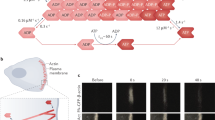Abstract.
Cytoskeletal rearrangement occurs in a variety of cellular processes and involves a wide spectrum of proteins. Among these, the gelsolin superfamily proteins control actin organization by severing filaments, capping filament ends and nucleating actin assembly [1]. Gelsolin is the founding member of this family, which now contains at least another six members: villin, adseverin, capG, advillin, supervillin and flightless I. In addition to their respective role in actin filament remodeling, these proteins have some specific and apparently non-overlapping particular roles in several cellular processes, including cell motility, control of apoptosis and regulation of phagocytosis (summarized in table 1). Evidence suggests that proteins belonging to the gelsolin superfamily may be involved in other processes, including gene expression regulation. This review will focus on some of the known functions of the gelsolin superfamily proteins, thus providing a basis for reflection on other possible and as yet incompletely understood roles for these proteins.
Similar content being viewed by others
Author information
Authors and Affiliations
Corresponding author
Additional information
Received 28 May 2004; received after revision 29 June 2004; accepted 8 July 2004
Rights and permissions
About this article
Cite this article
Silacci, P., Mazzolai, L., Gauci, C. et al. Gelsolin superfamily proteins: key regulators of cellular functions. CMLS, Cell. Mol. Life Sci. 61, 2614–2623 (2004). https://doi.org/10.1007/s00018-004-4225-6
Issue Date:
DOI: https://doi.org/10.1007/s00018-004-4225-6




